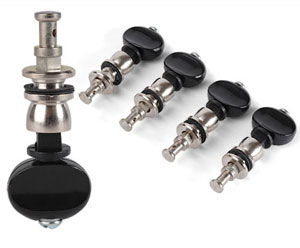Acoustic Banjo Bridge Pegs
The banjo happens to be quite popular among the African American community in the United States. It is said that this stringed instrument was brought to the new land by slaves, and was later enhanced to produce better notes. However, just as any other stringed instrument, the banjo needs to be in tune in order to be played correctly. This is one of the most difficult things to do with your acoustic banjo, and that’s why the bridge pegs are extremely important. Getting to know your banjo will slowly teach you how it’s supposed to sound like. It can be quite difficult to get used to it, but don’t be discouraged because with time, you will be an expert with your acoustic banjo bridge pegs.
African Tuning Pegs
Even though there are different theories on where the term banjo comes from, many believe it’s a derivative of mbanza, which is an African word. There is no doubt that there was some African magic brought to North America in the slave days. Part of this magic is the beautiful acoustic banjo, which was originally built with a wooden stick for a neck. The number of strings could vary, and most of the time it was up to the one who was making it. As time went by, the banjo was starting to get improved; one of the parts that was later incorporated was the bridge peg. With the bridge pegs, the acoustic banjos can come to a better tune because the strings are tightened, consequently producing a better sound.
Getting Modern With Your Banjo
Despite the fact that the original acoustic banjos were four and five-stringed, later on, a six-stringed banjo was created. To some, this was more similar to a guitar rather than a banjo, but it still became popular among the banjo fans. If you’re a guitar player, you’re probably used to referring to the large part of your guitar as the body. Well, when it comes to the acoustic banjo, the body is known as the pot. The pot is usually in the shape of a circle, and the strings are typically metal strings. In order to tune those metal strings, you will need to turn the bridge pegs on your acoustic banjo. And in order to achieve this, most banjo players use friction tuning pegs, as opposed to a gear machine head – which is commonly used with guitars.
Four Strings & Five Strings
Just like ukuleles and bass guitars, you will find different types of acoustic banjos. For example, the plectrum banjo features four strings and typically comes with 22 frets. The plectrum is mostly used in jazz due to its strummed chords. The tenor banjo is also four stringed and usually comes with 17 frets. The tenor is mostly played in Irish music, since it allows the player to match fiddle fingering. When it comes to five-string banjos, they are considered more modern and are very common in bluegrass music. In order to achieve the proper tuning, the player must know how to use the acoustic banjo bridge pegs. The correct tuning note may vary from one banjo to the other.

